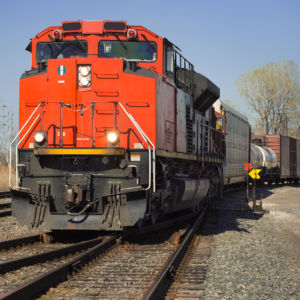How hard is the coronavirus lockdown hitting your community? Don’t check with the local bank or bakery. Head to the railyards.
Legendary investor Warren Buffet picked rail traffic as the single most accurate indicator of the economy’s overall health, a view backed up by analysis from both Merrill Lynch and AAM.
So, how’s the American economy doing based on the latest rail numbers? Just as badly as you’d expect during a government-ordered business shutdown.
According to the Association of American Railroads (AAR) weekly traffic report for the week ending April 11, rail traffic was down 21.9 percent compared with the same week last year. That’s a significant jump from the 15.9 percent year-to-year drop just a week earlier.
According to AAR Senior Vice President John T. Gray, rail traffic is currently down to levels associated with the Christmas and New Year’s holiday weeks, one of the industry’s slowest periods.
Imagine every American workplace operating at the same level of staffing and activity as Christmas week, and you have a disturbingly on-point portrait of the current economy.
“The pandemic is affecting firms in every industry, and railroads are no exception,” said Gray. “When rail customers suffer a drop in demand for their products, their need for transportation services declines as well, and that negatively impacts rail volumes.
“It’s still too early to say when the current crisis will end, but when it does — and it will — railroads will be ready to ramp up their service to safely, reliably and cost-effectively meet the freight transportation needs of our nation.”
In the era of smartphones and delivery drones, it’s easy to forget how vital the rail industry is to America’s economy. Railroads originate about 60,000 carloads of food and agricultural products in a typical week, and most of the products on the shelves of your local Walmart or grocery story got there thanks to rail intermodal volume.
(“Intermodal volume” refers to the container trucks seen on cargo ships and 18-wheelers, often containing consumer goods. They make up about a quarter of the total freight moved by rail, as opposed to the “coal, chemicals and cars” category, the products that prop up the economy overall.)
“The type of goods that are moving are things you really wouldn’t think about or even understand or realize that they’re moving via railroads all the time,” Ted Greener, AAR’s executive director for public affairs tells InsideSources. “A whole swath of chemicals including those used for manufacturing medicines, food packaging, disinfectants and treatments for clean water are being moved.
“Energy consumption is down, but we still are moving coal to those areas of the country that rely on coal for their electrification,” Greener said.
When it comes to food, Greener said there are reports of farmers discarding their foodstuffs, because restaurants and other food establishments are closed. “But from where we stand, we still move a good amount of grains and wheats and such,” he said. “There are lots of goods that are being used in the production cycle to feed Americans.”
Which may explain why rail employees were placed on the list of essential workers during the pandemic shutdown, and why there haven’t been widespread layoffs among the industry’s 150,000 employees, despite the drop in traffic. Rail workers also have to operate under new guidelines to slow the spread of the coronavirus in an industry that touches the entire nation from coast to coast.
The Federal Railroad Administration has issued a safety advisory calling on rail carriers to follow all guidelines on protecting rail workers’ safety.
“The FRA believes that actions consistent with this Safety Advisory will reduce the risk of railroad employees, contractors, and members of the public contracting or spreading COVID–19,” the advisory said.

